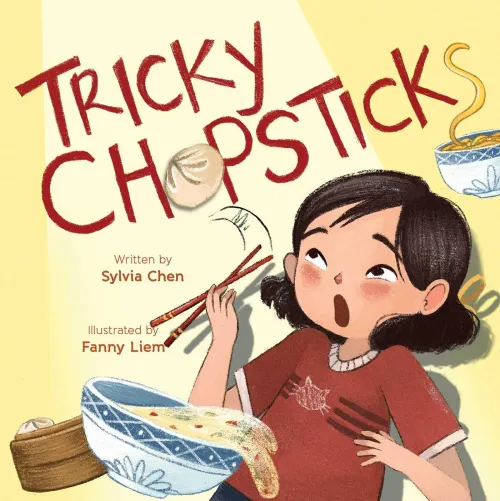Share this Book
Start off with a read-aloud of Tricky Chopsticks and then hold your own classroom chopstick challenge inspired by the activities presented in the Author’s Note. Have students follow the tutorial in the back of the book to make Jenny’s DIY chopstick tongs or let them take the challenge with plain chopsticks or their own DIY chopstick aid.
After giving everyone a chance to use their chopsticks to pick up marbles, pom poms, and rubber bands, invite students to take the next challenge! Ask them to think about tasks in their daily lives that feel tricky or challenging. Encourage them to follow Jenny’s example and work through different ideas to design their own “helper tool” that might make those tasks easier.
To guide students through the brainstorming and design process, help them clearly identify the specific tricky task they want to solve. Encourage them to think about tools they already know and how those tools work. Then have them sketch or describe multiple ideas, reminding them that it’s okay if the ideas aren’t perfect. When they have an idea they like, ask them to create a diagram of their helper tool, an explanation of how it should work, and a list of what materials and tools are needed to make it.
If materials are available, have students create prototypes and test their tools with their classmates or have them present their diagrams, gathering feedback and ideas for improvement. Wrap up by having students reflect on what they learned about the design process, the value of persistence, and how every tricky problem can be an invention waiting to happen!
Questions for Discussion or Reflective Writing
- How does Jenny feel about being the only one in her family who can’t use chopsticks? Have you ever felt like the only one who couldn’t do something? What did you do about it?
- Why does Jenny keep trying to learn to use chopsticks? What is something you’ve kept trying to do, even when it was hard? How do you feel when you don’t get something right the first time? What helps you keep going when you feel like giving up?
- Why is the chopstick challenge important to Jenny? What family traditions do you have that are important to you?
- How did she come up with her idea for her chopstick tongs? What other ideas did she try? What’s something you’ve built, made, or invented to help solve a problem?
- What do you notice about the way English and Chinese are both used in the book? How does seeing both languages on the page affect your reading experience?
Related Resources
How to Make DIY Chopstick Tongs Using an Origami Lucky Star from the Official Tricky Chopsticks website
Engineering Design Process from Teach Engineering
YES Elementary Engineering Design Process from the Museum of Science
More Titles to Try
Stay on top of current education news


